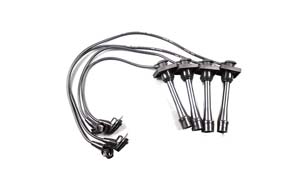Jul. 30, 2021
The function of an automobile spark plug is to ignite the fuel and air in the combustion chamber. They do this because of the signal received from the computer module or distributor cover.
If the ignition cable or spark plug wire carrying this signal fails, the operation of the engine will become untimely and underpowered. One or more cylinders may catch fire or weaken. Another result of incomplete combustion of fuel and air is the accumulation of gas and residue in the injector or cylinder.
Symptoms of a failed ignition cable include rough idling, illuminated check engine lights, and general lack of an engine. These can be easily avoided with a few simple steps.
Replace the ignition cable
Materials needed
Ignition cable (or spark plug wire) removal tool (optional)
Pliers (optional)
Replacement cable
Socket set and ratchet
Spark plug wire grease (optional)
Tip: When purchasing a replacement, make sure that the length of the replaced ignition cable is correct. If necessary, use your old cable as a reference. The position of the cable on each cylinder will determine the length of the cable from the distributor or module.
Step 1: Disconnect the battery. Disconnect the negative battery cable and cut off the power supply of the ignition cable.
Use a socket or wrench to disconnect the bolt that connects the cable to the terminal.
Warning: Put the negative battery cable aside to prevent it from contacting any metal, otherwise power may be restored to the cable.
Step 2: Locate the ignition cable. The cables will be routed from the spark plugs on the top of the gas cylinders to the distributor caps or modules that power them.
Step 3: Replace the cable. Remove and replace the spark plug wires one by one.
Only make one at a time, so you don't have to worry about accidentally messing up the wires.
When removing the old cable, first pull the cable directly upward on the spark plug end, and then pull upward the boot connected to the distributor cover or the module upward. Be sure to only wear boots; do not pull on the cable itself.
Tips: If you are sure that you will no longer use the old spark plug cables, you can use a pair of pliers to help you remove them. The vise is likely to damage the lead and terminal of the old wire, so it is not recommended that you use the vise for any ignition cables that you plan to reuse. Otherwise, you can remove the tool by hand or with a spark plug.
Again, make sure that the length of the cable you disconnected is the same as the length of the new cable. The extra wires are unnecessary, and your engine may not have room to compensate.
More important than matching the cable length is not to confuse the order of the ignition cables. The spark signal is sent to each cylinder in a specific order to the time when the piston is at the top dead center (at the top of the cylinder). Improper installation of these cables may cause poor combustion or cylinder misfire, which will cause drivability problems and may cause serious damage to the engine.
Tip: If the order of the wires is confused, check the ignition order of your exact vehicle as a reference.
When removing spark plugs or ignition cables, check for signs of other problems with your vehicle. The easiest to find are signs of carbon or oil burning. This indicates that the bonnet gasket and/or o-ring around the old spark plug have failed.
To install the new cable, push one end of the new ignition cable onto the module, and then push the other end onto the spark plug.
Tip: If you wish to use spark plug wire grease (dielectric grease), insert a small drop of grease into the new starter before placing it on the spark plug.
Move to the next cable and repeat this step.
Step 4: Reconnect the battery. Reconnect the negative battery cable to the terminal to restore power.
Tighten the fixing bolts by hand, and tighten them with a wrench or socket.
After completing this step, please close the hood.

ignition cable
Step 5: Test drive the vehicle. After the car is parked, start the car. If the idle speed remains stable between 600-1000 rpm, perform a test drive and observe the driving performance of the vehicle.
Note: Listen for stuttering, rough idling, and failure, and feel any sluggishness.
The ignition system of a vehicle plays a very important role in its operation. Problems with the ignition system will slow down your engine and lose power. Long-term use under these conditions will cause various damages and wear out other related parts. If you follow the steps outlined in this guide, you can fix these problems and avoid further damage.
Quick Links
Tel.: +86 135 7412 6921
Mob.: +86 135 7412 6921
E-mail: hifuly@foxmail.com
Skype: linda.hava
WhatsApp: +86 135 7412 6921
QQ: 2850162377
Follow Us